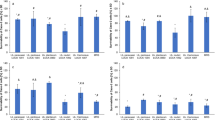Abstract
Forty strains of enterococci and forty strains of lactobacilli isolated from feces of 10 healthy dogs were tested for the antimicrobial activity, tolerance to bile and adhesion activity. The total count of fecal enterococci reached 5.5 log CFU/g and of lactobacilli 7.6 log CFU/g. Screening for production of bacteriocin-like substances showed an to partly inhibit the growth ofEnterobacter sp. (hazy zones of inhibition). Ten strains ofEnterococcus sp. and nine strains ofLactobacillus sp. were found without any inhibitory activity against all indicators used. Seven enterococcal strains and six lactobacilli with the broadest antimicrobial spectrum were selected for further probiotic assays. In the presence of 1 % bile, the survival rate of selected enterococci (71.7–97.5 %) was higher than that of lactobacilli (66.7–75.4 %). The adhesion of strains to human intestinal mucus (5.1–8.2 % by enterococci, 2.7–8.3 % by lactobacilli) was found to be similar as adhesion to canine intestinal mucus (3.7–10.6 % by enterococci, 2.1–6.0 % by lactobacilli). Strain AD1, one lactobacillus isolate, reduced the higher level of serum cholesterol and alanine aminotransferase after oral administration to dogs suffering from diseases of the gastrointestinal tract.
Similar content being viewed by others
Referencés
Alander M., Satokari R., Korpela R., Saxelin M., Vilpponen-Salmela T., Mattila-Sandholm T., von Wright A.: Persistence of colonization of human colonic mucosa by a probiotic strain,Lactobacillus rhamnosus GG after oral consumption.Appl.Environ.Microbiol.65, 351–354 (1999).
Baele M., Baele P., Vaneechoutte M., Storms V., Butaye P., Devriese L., Verschraegen G., Gillis M., Haesebrouck F.: Application of tDNA-PCR for the identification of enterococci.J.Clin.Microbiol.38, 4201–4207 (2000).
Caplice E., Fitzgerald G.F.: Food fermentations: role of microorganisms in food production and preservation.Internat.J.Food Microbiol.50, 131–149 (1999).
Casas I.A., Edens F.W., Dobrogosz W.J.:Lactobacillus reuteri: an effective probiotic for poultry and other animals, pp. 475–518 in S. Salminen, A. von Wright (Eds):Lactic Acid Bacteria: Microbiology and Functional Aspects. Marcel Dekker, New York 1998.
Du Toit M., Franz C.M.A.P., Dicks L.M.T., Holzapfel W.H.: Preliminary characterization of bacteriocins produced byEnterococcus faecium andEnterococcus faecalis isolated from pig feces.J.Appl.Microbiol.88, 482–494 (2000).
Elliott S.E., Buret A., McKnight W., Miller M.J.S., Wallace J.L.: Bacteria rapidly colonize and modulate healing of gastric ulcers in rats.Amer.J.Physiol.275, G425-G432 (1998).
Gilliland S.E., Walker D.K.: Factors to consider when selecting a culture ofLactobacillus acidophilus as a dietary adjunct to produce a hypocholesterolemic effect in humans.J.Dairy Sci.73, 905–911 (1990).
Havenaar R., Ten Brink B., Huis In’t Veld J.H.J.: Selection of strains for probiotic use, pp. 209–221 in R. Fuller (Ed.):Probiotics — the Scientific Basis. Chapman and Hall, London 1992.
Klaenhammer T.R.: Genetics of bacteriocins produced by lactic acid bacteria.FEMS Microbial Rev.12, 224–227 (1993).
Larsen L.A., Raben A., Haulrik N., Hansen A.S., Manders M., Astrop A.: Effect of 8 week intake of probiotic milk products on risk factors for cardiovascular diseases.Eur.J.Clin.Nutr.54, 288–297 (2000).
Nes LF., Diep D.B., Havarstein L.S., Brurnerg M.B., Eijdink V., Holo H.: Biosynthesis of bacteriocins in lactic acid bacteria.Antonie van Leeuwenhoek70, 113–128 (1996).
Osuntoki A.A., Gbenle G.O., Olukoya D.K.: Evidence for chromosomal determination of fungicidal activity in strains ofLactobacillus brevis andLactobacillus fermentum isolated from fermented foods.Folia Microbiol.48, 56–58 (2003).
Ouwehand A.C., Kirjavainen P.V., Shortt C., Saminen S.: Probiotics: mechanisms and established effects.Internat.Dairy J.9, 43–52 (1999).
Rinkinen M., Mättö J., Salminen S., Westermarck E., Ouwehand A.C.:In vitro adhesion of lactic acid bacteria to canine small intestinal mucus.J.Anim.Physiol.Anim.Nutr.84, 43–47 (2000).
Salminen S., von Wright A., Morelli L., Marteuau P., Brassart D., de Vos W.M., Fonden R., Saxelin M., Collins K., Mogensen G., Birkeland S.E., Mattila-Sandholm T.: Demonstration of safety of probiotics — a review.Internat.J.Food Microbiol.44, 93–106 (1998).
Schaafsma G., Meuling W.J.A., Van Dokkum W., Bouley C.: Effects of a milk product, fermented byLactobacillus acidophilus and with fructo-oligosaccharides added, on blood lipids in male volunteers.Eur.J.Clin.Nutr.52, 436–440 (1998).
Schrezenmeir J., de Vrese M.: Probiotics, prebiotics, and synbiotics — approaching a definition.Amer.J.Clin.Nutr.73 (Suppl.), 361S-364S (2001).
Strickling J.A., Harmon D.L., Dawson K.A., Gross K.L.: Evaluation of oligosaccharide addition to dog diets: influences on nutrient digestion and microbial populations.Amm.Feed Sci.Technol.86, 205–219 (2000).
Tannock G.W.: Microbial interference in the gastrointestinal tract.ASE Amer.J.Clin.Sci.2, 2–34 (1981).
Tomita H., Fujimoto S., Tanimoto K., Ike Y.: Cloning and genetic organization of the bacteriocin 21 determinant encoded on theEnterococcus faecalis pheromone-responsive conjugative plasmid pPD1.J.Bacteriol.179, 7843–7855 (1997).
Welsh J., McClelland M.: Genomic fingerprints produced by PCR with consensus tRNA gene primers.Nucl.Acids Res.19, 861–866 (1991).
Xanthopoulos V., Litopoulou-Tzanetakis E., Tzanetakis N.:In vitro study of lactobacillus species strains on bile tolerance and cholesterol removal, inLactic Acid Bacteria — Lactic 97. Presses Universitaires de Caen, Caen 1997.
Zentek J., Molitor D., Kamphues J.: Prüfung intestinaler Effekte eines Probiotikums (Enterococcus faectum) bei Hunden.Kleintierpraxis43, 187–197 (1998).
Author information
Authors and Affiliations
Corresponding author
Additional information
This study was supported by project VEGA 2/2043/23 ofSlovak Scientific Agency.
Rights and permissions
About this article
Cite this article
Strompfová, V., Lauková, A. & Ouwehand, A.C. Lactobacilli and enterococci — Potential probiotics for dogs. Folia Microbiol 49, 203–207 (2004). https://doi.org/10.1007/BF02931403
Received:
Revised:
Issue Date:
DOI: https://doi.org/10.1007/BF02931403



